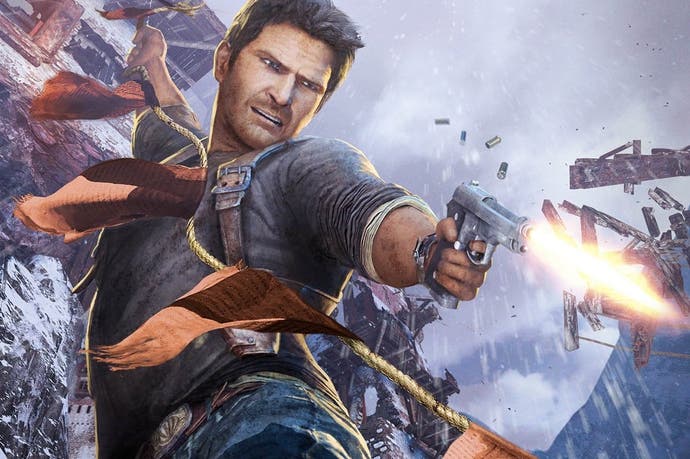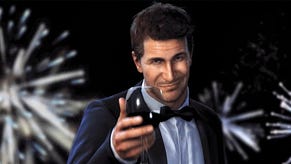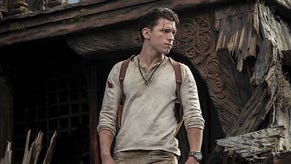Among Friends: How Naughty Dog Built Uncharted 2
From the archive: behind the scenes on the making of a genuine last-gen classic.
Digital Foundry is currently en route to GDC 2015, so there won't be a new article published today. However, as we make the long journey across to San Francisco, we're reminded of the first - and possibly the best - GDC talk we saw. That would be then-Naughty Dog Richard Lemarchand's hour-long journey into the making of Uncharted 2: Among Thieves, a title that remains one of the greatest games released in the last-gen era. A remarkably insightful talk that gave us fantastic background into the way Naughty Dog worked, we couldn't help but think that the presentation would translate into a great feature - and to this day this remains one of our favourite pieces. Originally published on the March 20th 2010, this is an article we're happy to share with you again.
Speaking at GDC 2010, Naughty Dog lead game designer Richard Lemarchand gave a candid presentation on the development of Uncharted 2: Among Thieves - a post-mortem of the game-making process that covered, in his own words, "what went right and what blew up in our faces like a red explosive barrel!"
Just one face in a crowd of hundreds, it's a unique opportunity to get a glimpse at the game-making philosophies and techniques of one of the world's leading developers. Here we recap the session in detail and expand upon it with Naughty Dog's assistance and our own unique visual assets. Enjoy!
"We start every new project with a shortlist of project goals and refer back to them throughout development to make sure that we stay on track," says Richard Lemarchand. "Our top-line goal was that we wanted to create something that a lot of us at the studio had dreamed about for a really long time: that is to say, a fully playable version of a big summer blockbuster action-adventure movie which kept the player in moment-to-moment control nearly all the time as drama exploded around him."
Lemarchand and Naughty Dog also sought to expand upon the strong character-driven premise of the first Uncharted, but with even more ambitious aims for the sequel.
"Our story in Uncharted is character-driven rather than plot-driven and we decided to include a larger cast of characters in Uncharted 2," Lemarchand explains. "The other characters would help to show us more of the world that Nate operates in and would act like emotional satellites, revealing more about the good and the darker sides of Nate's character.
"While Uncharted: Drake's Fortune [the first game] had greed and its consequences as the main theme, Uncharted 2: Among Thieves would be about trust and betrayal and whether it's better to stay loyal to your friends or to act in self-interest."


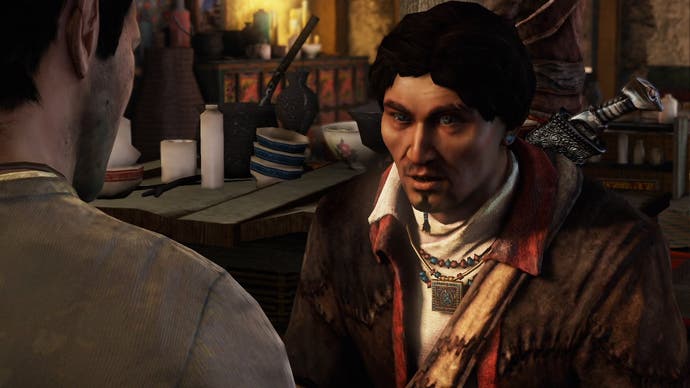
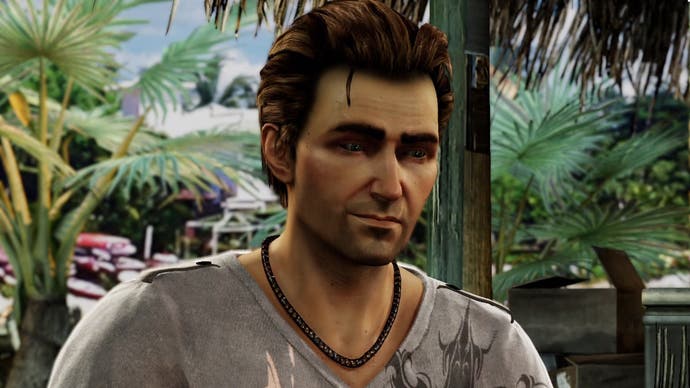
The first Uncharted worked hard in melding gameplay and story into one coherent, almost seamless experience, and the Naughty Dog team pursued this "playable cinema feel" that would drive many of the different improvements to the technological side of the project, while prioritising a wide range of graphical enhancements to the team's proprietary engine.
In addition to that, multiplayer was green-lit for the sequel, with the co-op elements only being added very late on in the development cycle. "We knew that at the very least we wanted to make a competitive game with several different game types," says Lemarchand.
Uncharted 2 was created in a total of 22 months, and six months of that schedule was spent in pre-production.
"The way we handle pre-production at Naughty Dog is one of the things that we think makes us unusual as a studio, in that during pre-production we don't have anything in the way of conventional deadlines or deliverables," Lemarchand explains.
"Our pre-production period is a very freeform time where we brainstorm, we talk about gameplay and story ideas, make lots of concept art and pre-visualisation animations and we do as much prototyping of gameplay as we can with whatever tools we have at hand. By doing this we quickly come up with a handful of game ideas that are simply too good not to include in the game."
One such idea was a gameplay equivalent to the epic Paro Taktshang, the so-called Tiger's Nest monastery in Bhutan in the eastern Himalayas. Just a single photo of this incredible spectacle fired the imagination of the Dogs.
"The way that the monastery seemed to cling on to the side of the cliff seemed perfect for Uncharted," enthuses Lemarchand. "The photo gave us a good grounding in reality for the larger-than-life scenario that we invited, and was also suggestive of the kind of perilous climbing gameplay that we love so much, so we soon began to design a level based on the Tiger's Nest, long before we had any real idea of how it fit into the rest of the game."
The second tent-pole idea was the concept of Drake fighting on the top of a train as it sped through the landscape. However, with Naughty Dog adopting its signature perfectionist approach, the team wanted to execute the concept in a way never seen to date in a videogame.
"We didn't want to go down the same route that videogame train levels had taken in the past where the train is actually static and the ground is scrolling by, creating the illusion of movement," Lemarchand explains.
"We wanted to do it for real... gameplay ideas like these in pre-production can drive the technology part of the game. This level was one of the first we conceived and one of the last that we completed and it drove an enormous chunk of the new technology we created for Uncharted 2."
One of the centrepiece tech components was a system dubbed by the team as the "dynamic object traversal system", which essentially allowed Drake and all the other characters in the game to use their moves and combat techniques on any moving object or environment.
"This might not seem like a big deal but for those of us who have been working on 3D character action games for a while, it was pretty much the Holy Grail because it allowed us to do things that we'd only been able to dream of before," Lemarchand explains.
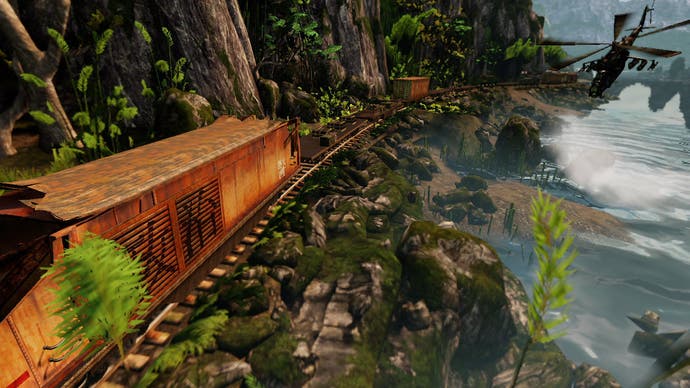

"It was amazingly complicated to get this to work. Our programmers had to touch or rewrite nearly every system in the game from the player control to objects to collision to enemies and allies AI... Taking the leap to do something like this took a lot of tenacity and courage, and we had to keep going even when it felt like an impossible task, but it paid off in countless ways - from the collapsing hotel to the convoy, Uncharted 2 was able to stand out of the crowd and wow our players with things they'd never seen before."
One of the game's most celebrated sequences - the Himalayan village - was also dreamed up during this crucial six months of development.
"One more idea that emerged from pre-production was that of Nate collapsing in the snow and being rescued by a mysterious stranger that for a long time we just called The Rescuer," Lemarchand reveals. "Nate would then wake up in a peaceful Himalayan village and discover that the saviour was a village leader called Tenzin and that they didn't share a common language.
"We planned that Nate would leave the village with Tenzin to explore a puzzling mountain cave system, before returning to find the village now under attack by a well-equipped army. We thought that this would create a particular sequence of emotion for the player almost entirely through gameplay. Even though much of the rest of the story was still undecided we were able to stick a pin in this idea and proceed confident that it would find a home in the game."
Literally the only tangible document that was derived from this half-year of hard work was the so-called Macro design, literally just an Excel spreadsheet, but hugely important for the developmental effort.

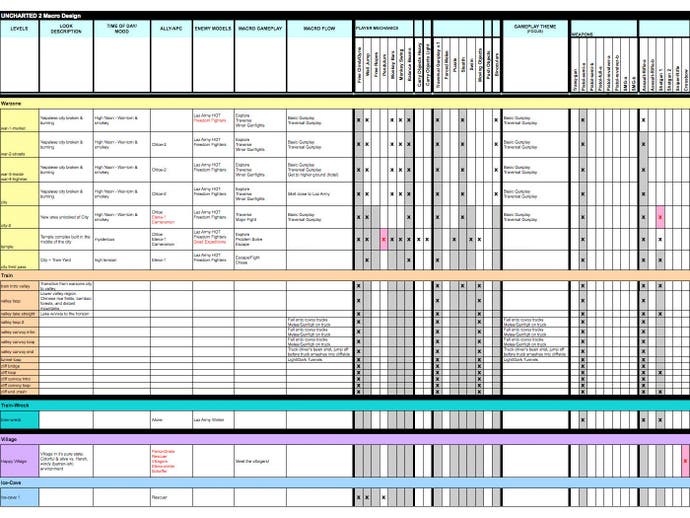
"It's a list of levels and corresponding story beats that shows the locations the game visits, what play mechanics are used in each level and whether they're core mechanics or special gameplay sequences," as Lemarchand puts it. "It shows what enemies the player will encounter and what allies will accompany Drake on each stage of his journey."
Nate's moves list was also significantly fleshed out, the idea being to make him even more adaptable, capable... and dangerous.
"We wanted to Drake to have the ability to pull out a gun and fire no matter what he was doing in the world, whether it was climbing, balancing on a fallen beam - even when he's in mid-air during a jump," says Lemarchand. "It didn't take us very long to flesh out his abilities, expanding Drake's traversal options like this was good for devising combat scenarios because we could throw down some enemies in any section of the game and in that way discover novel combat set-ups in the most unexpected traversal sequences."
The original Uncharted also had the occasional flash of stealth gameplay, with bespoke animations and combat techniques where Drake could surprise enemies from behind and take them down silently. This was massively expanded in the sequel and became a core part of the gameplay.
"We also started work early in pre-production in improvements in AI that let players choose to engage with our combat setups in an action-stealth way," Lemarchand explains. "We gave our enemies an 'investigate' behaviour that they use when they hear or see something unusual and also a 'search behaviour' they would use if they had seen Drake but didn't currently know where he was. These techniques paid off right through the whole player experience so it was really good that we got started with them early in pre-production."
The final piece of the puzzle that was established in this phase of development was the methodology in handling Uncharted 2's epic set-pieces.
"One particular sequence from Uncharted: Drake's Fortune had stuck in our minds and really fired our imaginations," remembers Lemarchand. "It's a simple sequence from the Island Waterfall where an explosion near a truckful of enemies flips the truck and forms a bridge.
"It was a really dramatic moment, like something from one of our favourite action-adventure movies, and played out almost entirely in gameplay. It made us feel that we had only just begun to scratch the surface of what was possible in terms of delivering a truly interactive cinematic experience and we thought that making bigger set-pieces and moving away from so-called quick time events was probably the right way to go."
The Dogs realised that expanding this concept into truly spectacular set-pieces would involve a huge amount of work, and the first section they tackled was an early rendition of the collapsing bridge from the monastery level near the end of the game. The team realised that these sections would be incredibly time-consuming, and specialist technical scripting designers were hired to make sure enough manpower was on tap to get the job done, but even then, it was a massive task that dominated the production schedule.
Meanwhile, other team members in the Naughty Dog kennel spent the pre-production cycle simply... building stuff. According to Lemarchand, during the first Uncharted too much time was spent theorising about game design rather than getting on and doing it.
"We did our best to hit the ground running with Uncharted 2," he remembers. "The team was keen to keep up the production momentum built up over the previous three years with Uncharted: Drake's Fortune and using the first ideas we had, everyone could get down to creating art, implementing game mechanics and laying out levels almost immediately. By the time we hit full production we were in much better shape than we had been at the same stage during our last project."
The only real risk the team took with this approach was what Lemarchand describes as reaching a "soft end" to the pre-production phase, as the team transitioned into the full-on development of the actual game. All of the game-building going on had resulted in the all-important Macro design not being as final and complete as the team realised they would have liked.
"It took us a long time to figure out how the story would come together in the monastery in particular," Lemarchand muses. "When you play it through you might notice that there aren't really enough strong story beats there to match the length and the intensity of the gameplay and it's the first place in the game where the pace of the experience begins to lose steam a bit. Of course as soon as we realised what was happening, we scrambled to patch things up. At the end of the day we had committed too much to the level in terms of final art and we couldn't really bring about a perfect fix."
The lesson here for Naughty Dog was to firmly establish all elements of its Macro design before moving into full production. The gameplay should match the rising and falling rhythms of the story, and weak elements of the Macro need to be firmed up before too much in the way of final art is completed. Lemarchand pinpoints parts of the game where level design starts early and story design finishes late as the areas that should get special attention.
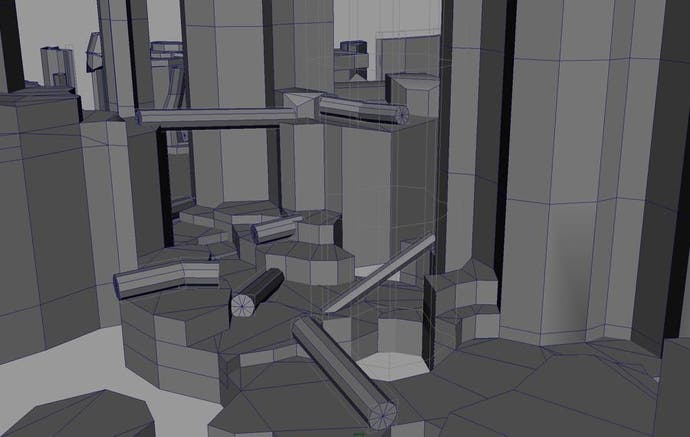
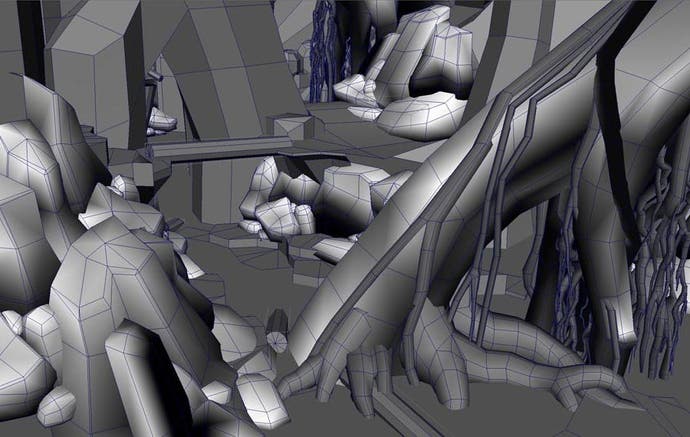
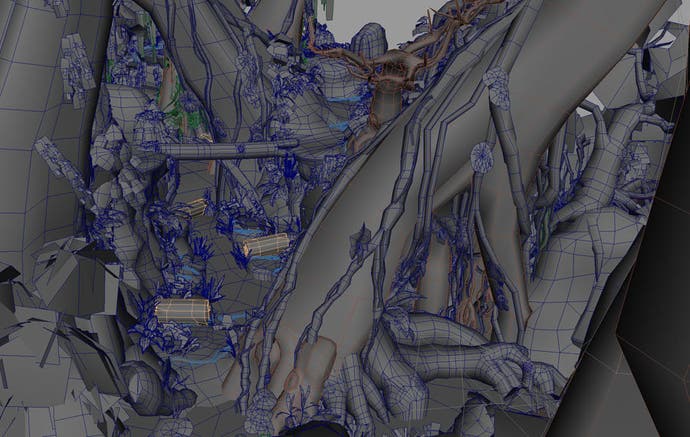

April 2008, and the Naughty Dog team move onto full production of Uncharted 2. Now Micro design is created to accompany the Macro. Levels take shape, play mechanics are developed and the game proper begins to take shape.
"We do this Micro design work on a just-in-time basis, a bit like Gromit laying out the toy train tracks only just ahead of himself in 'The Wrong Trousers'. We had gotten a leg-up with the level layout during pre-production and we were just far ahead of the team that we were able to move forward smoothly," says Lemarchand.
"Even though this way of working might seem like a seat-of-the-pants way of doing things, in truth we think that it's the way that a lot of game development happens and we just have the courage to make it an official part of our process."
The team's "just build it" approach saw the traditional paper map method of level-creation taking a backseat. Levels were sculpted in a basic 3D form, dubbed "block mesh" by the team.
"We started by sketching out an experiential flow for the player then meeting with the artists and programmers who would be working on the level to get their input and ideas," Lemarchand explains. "Then we just started building simple geometry in Maya, roughing out a physical footprint for the level and playtesting it on literally anyone who came within arm's reach and getting constructive input from as many different people as possible.
"We started to do paint-overs with our concept artists to move our conception of the look of the level along and after that, it was simply a question of iterating as much as quickly as we could before handed off the block-mesh to our environment artists who would continue to iterate on the level, making progressive detail passes until we eventually arrive at the finished art."
The only issue with this approach was what Naughty Dog came to see as missed gameplay opportunities that more traditional level-planning may have brought to the table. Also, what a level designer envisaged as a blank wall could end up getting a lot of fine-detailing, making it look more important and more interactive than it was actually supposed to be.
"Unfortunately this is a pretty serious problem in Uncharted 2, especially in detail-rich areas," says Lemarchand. "In future we're going to try to find a better balance as regards these aspects of our layout process and we're going to have more of a layout focus on realistic architecture earlier and how its details will affect the player's experience."
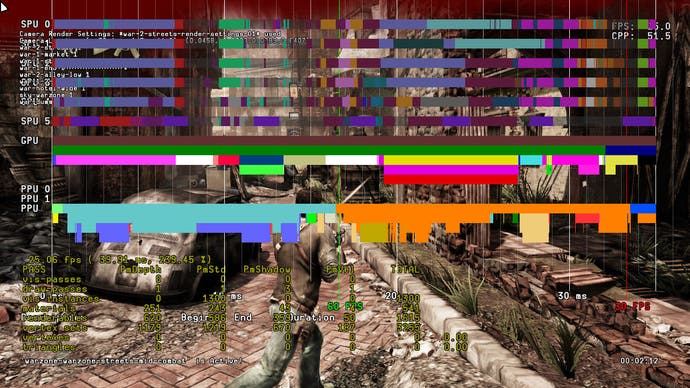
Inordinately large asset lists were created for each level covering objects, sound effects, visual effects and animations that were needed. The Naughty Dog team soon realised that the scope of their ambition far exceeded what they had handled in the three-year development period of the original Uncharted: Drake's Fortune.
"We need an enormous volume of entities to create a game like Uncharted 2," says Lemarchand. "For example we had 80 in-game cinematic animations - that we call IGCs - in Uncharted: Drake's Fortune, but we had 564 IGCs in Uncharted 2. This is an amazingly large amount of work to requisition and produce on an ad-hoc basis so the leads of each department needed to juggle their priorities a lot and work hard to get everything built in the right order."
Digital Foundry has talked often and at length about Uncharted 2's status as the most technologically advanced videogame available on the current generation of consoles - a state of affairs only challenged by the recent God of War 3. The vast range of enhancements and tech improvements saw the Dogs' internal tech rechristened as the Naughty Dog Engine 2.0.
"We went Cell processor-crazy on Uncharted 2. We were famous for saying that Uncharted: Drake's Fortune only used about 30 per cent of the capacity of the Cell processor," says Lemarchand. "So from the very beginning of the project, the programmers focused on making sure that we squeezed every last ounce of performance out of the Cell. The key to doing this was to decide which of the jobs we wanted to farm out to the Cell and then writing hand-optimised code to do those jobs as efficiently as possible."
Unbelievably, considering that the original Uncharted is still such a beautiful-looking game, almost all of its visual effects were achieved using the RSX graphics chip pretty much in isolation. For Uncharted 2 - and indeed many recent games - Cell is used as a parallel graphics processor working in tandem with the RSX. Tasks traditionally associated with the GPU are passed off to the Cell's SPUs.
What this means in basic terms is more time for the RSX to do its thing while the Cell takes care of the vast majority of Uncharted 2's excellent post-processing effects. Screen space ambient occlusion (SSAO), for example, was all done completely on the Cell.
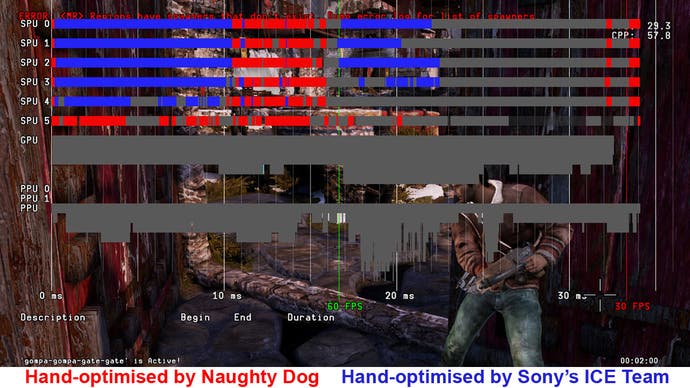
"The SPUs gave us an increase in the quality of our bloom effects," Lemarchand adds. "Depth of field, which was kind of a hack in the first Uncharted, was a much more physically correct solution in Uncharted 2, which made the times that we used it in the service of cinematography that much more powerful as a story-telling tool.
"We also implemented a filmic HDR response curve and Uncharted 2 has a much wider range of colours between light and dark than its predecessor making it look much more like the game was shot on film, supporting our goal of making a cinematic reality."
All of this enhanced tech came at a price though and as Lemarchand puts it, with just nine months before launch, the team "suddenly realised that our frame-rate was to put it bluntly, pretty crap". According to Naughty Dog co-president Evan Wells, Naughty Dog received technological assists from Insomniac Games and Killzone creators Guerrilla Games in implementing the triple-buffer v-synced technique that completely eliminated the tearing from Uncharted.
"We had to mobilise to fix it and right up to the end of the project we had a huge focus on frame-rate," remembers Lemarchand. "Both our programmers and artists had to work very hard to make sure that we hit 30FPS consistently throughout the whole game and so banish some of the issues with tearing and stuttering that we experienced with Uncharted: Drake's Fortune. We had to give people the analytic tools they needed to keep the game inside the frame-rate and we had to make a memory sacrifice to achieve the triple-buffering solution that finally got rid of the tearing."
Technologically speaking, the game concepts the Naughty Dog designers had come up with during pre-production were affecting and indeed helping to redefine engine performance and capabilities throughout the development cycle.
"The train level was one of the first levels we started on and one of the last that got finished and to be frank it was an evil monster of a level to create," Richard reminisces. "There are 50 separate cars that are really moving along through our streaming environments at a pretty good lick. You can see all 50 cars at pretty much any time during the level and when we first started to build the level, when we looked at the first car from the last car, a little lamp hanging on the front of the first car was still swinging! We hadn't really used a level of detail (LOD) system in the first Uncharted but the train level made us put it into action in double-quick time."
The Naughty Dog dynamic object traversal system was being pushed to its limits by the train stage, with the team stubborn in its belief that the train should only progress in the world if the player - and everything else in the level - was moving along with it.
"In order to make this happen we had to do a lot of weird stuff, sometimes teleporting the train into new positions, depending on what you did," explains Lemarchand. "And this, combined with the general craziness of doing the train level led to a lot of bugs, particularly with the enemies' navigational systems. They were getting confused every time the train teleported for instance.
"Also, for a long time, when you shot the enemies and they dropped their weapons, the weapon would zoom off down the track as it shifted into the coordinates system of the world. Even better than that, grenades would fly back into your face and blow you up.
"To cap things off, we realised at one point that the player's gun-aim raycasts were aiming at where the enemies had been a frame ago. This hadn't made much difference in most of the levels but in the train level the enemy was back down the track two metres a frame ago, so suddenly your aim was two metres off. So that was just another bug that we had to fix."
Fixing those bugs in the most extreme of cases meant that the gameplay mechanics throughout the entire game were tightened up as a consequence. Every system was made more robust owing to the developmental headaches inflicted by that one level. As Lemarchand puts it:
"We could say to each other, 'If it works on train, it must work everywhere!' In other words, not only had we made our game run at 30 frames per second, we'd also made it run at 60 miles per hour!"
Another example of game systems being tightened across the board came about through Naughty Dog's multiplayer code. Genuine concerns from gamers about the single-player experience suffering owing to the inclusion of network play turned out to be unfounded based on the quality of the final product. Indeed, from the team's perspective, incorporating multiplayer added to the polish of the single-player experience.
"Some internet-posting fans of Uncharted: Drake's Fortune were concerned that our single-player game would suffer as a result of the attention that we'd have to give our multiplayer game," remembers Lemarchand. "Even though we did have to do a lot of hard work to realise our ambitions it turned out that the multiplayer actually helped the single-player game.
"We had to tighten up the player mechanics and make them a lot snappier once we'd got them into the multiplayer context. That actually fed back into the single-player game and gave it a much better, tighter feel. These are the kind of synergies we love to find when we're building a game and we're always on the lookout for them."
The basics of the multiplayer mode were incredibly straightforward - Drake's move-set from the single-player game was dropped straight into the new networked modes and as Lemarchand notes, "it immediately felt right". The baseline net code itself was written by one of the Naughty Dog co-presidents, adding to his already considerable workload.
"Christophe Balestra wrote all of our networking code in-house from the ground up," shares Richard Lemarchand. "He gave us a very solid base to build our multiplayer game on and he was able to support us throughout the whole of development even though he had a lot of other responsibilities."
Naughty Dog hired a dedicated multiplayer designer in August 2008, and as the multiplayer game took shape, half-hour playtests were scheduled daily in the Naughty Dog kennel, with the whole office invited to participate.
"The short, often very heated discussions that would take part after the playtests were vital in helping refine the multiplayer gameplay and troubleshooting," notes a smiling Lemarchand.
Co-op missions set in what the team call "alternate realities" of existing single-player missions were also scheduled, but this only came about some time into full production and in retrospect, the Naughty Dog team felt that at this point maybe they were beginning to push themselves too far in terms of the torturous workload. As 2009's E3 drew closer, the developers started to feel the harsh realities of getting stages of the game in a state fit enough for public consumption.
"About two months out from E3 last year we started to organise what we were going to show at the event," Lemarchand remembers. "We had two big deliverables: a playable demo of a section of the game in our fictional Nepalese city and a movie-style trailer that would show a lot of different parts of the game.
"However, while we had started work on everything we wanted to show, a lot of the assets and gameplay were going to need a great deal of polish if they were going to be as impressive to E3 attendees as we wanted them to be. We often do this with our projects at Naughty Dog: using a deadline showing our game to the public to drive production. The raw terror this inspires certainly gets us to buckle down to some serious polish!"
The E3 demo of Uncharted 2: Among Thieves was one of the undoubted highlights of the Sony presser, notable in that instead of relying on canned footage, Naughty Dog co-president Evan Wells gave what Richard Lemarchand describes as "an amazingly sure-footed live drive" on stage during the event. The accompanying trailer that was released at the event also put the scale of the task in finishing the game into perspective for the developers.
"The next time you watch that E3 trailer, bear in mind that the things you see in there were almost the only things finished to that level of polish," shares Lemarchand. "If the camera had turned just a metre to the left or the right, you'd have seen behind the scenes - and not in a very good way. Making the demo and trailer was very useful. It told us exactly how much work we'd have to do to get it up to a level of polish we were happy with. We found out that was a lot of work."
Despite the long hours being put in by the Naughty Dog team, the scale of the task facing the team remained colossal.
"It was around this time in June 2009 that we realised how much game we'd bitten off. We'd either have to chew extra hard or make some cuts. Or choke," says Lemarchand.
"Between multiplayer, co-op and the single-player mode, we'd been really ambitious, probably over-ambitious. In particular, even though we'd tried to plan for them, the set-pieces in single-player mode took much longer to create and polish than we'd anticipated. Putting them together was immensely difficult - far worse than some of us had experienced even in our most brutal crunches."
Naughty Dog's solution was to streamline the game without unduly affecting its flow.
"We set about seeing where we could make some cuts and reduce the scope of the game," explains Lemarchand. "We managed to make layout reductions to several levels early enough that we hadn't invested that much in terms of art resources in the affected levels. We'd also lived with the prototype block mesh versions of the levels long enough that we could see fairly clearly what we should keep and what we should cut."
There's no mandated crunch at Naughty Dog, but as Richard puts it, "we have hired people with personality types that make them hard-working, willing to accept responsibility, and perfectionist."
Downtime became a very precious and rare commodity as the Uncharted 2 development cycle drew to a close and lessons were learned in how the team plans to approach the final months of its next game.
"While we don't think we'll ever be a studio that works nine-to-five year round, we do take the threat that crunch presents to the integrity of the studio and the wellbeing of the Naughty Dogs very seriously," observes Lemarchand.
"We're continuing to discuss ways so that we can avoid ever having to repeat the experience of Uncharted 2 in terms of the toll that the project's crunch took. We know that we have to become more disciplined about setting and hitting internal targets as well as external ones to get more traction on our projects earlier. We're going to try other approaches like putting mandatory limits on the amount of time people can spend at the office."
Part of what makes Uncharted 2 the game that it is comes down to the process of refining the gameplay experience - polish, as Richard Lemarchand calls it. Part of that involves getting gameplay tested as much as possible. The Naughty Dogs worked on the principle of testing each other's contributions to the game, but a fresh perspective on the work proved to be invaluable.
"In the course of Uncharted 2 we did more play-testing than we'd ever done before, running 15 play-tests over the last 10 months of the project compared with only seven throughout the whole three years of the developed of Uncharted: Drake's Fortune," shares Lemarchand.
"These were formal play-tests with members of the general public who played as much game as we had right through. Play-testing and metric data analysis have always been very important tools for us but they were very important in Uncharted 2 because the complex sequences of gameplay only came together very late in the project and in order to ensure we were not introducing any difficulty spikes we had to scramble to add additional 'sanity check' play-tests right up to just days before gold master."
As the play-testers ran through the game, metric data of their gameplay was phoned home across the Naughty Dog network: elements like how long it took a player to complete a part of the game, or how frequently they died between checkpoints.
"We put that data into a spreadsheet and looked at the maximum, minimum and median values for each point of data, colour-coding cells that had values above certain targets" Lemarchand continues. "Parts of the game that were potentially problematic immediately jumped out at us and we could then look at the gameplay vids we'd recorded during the play-test sessions to investigate each potential problem. One poor player had to play the train level fight 27 times before they finally beat it. That was horrifying when we saw that. Luckily we were able to spot that and fix it."
As the game's development progressed towards its eventual conclusion, levels were locked down and completed in groups rather than the whole game coming "due" on the same date.
"With a game as large as the one we were making it made sense to do this in order to have fewer moving parts as we moved closer to the end of the project," Lemarchand explains. "We'd always planned to have long alpha and beta periods of six weeks each. We simply needed that much polish and bug-fixing time for the game that we'd made and we're firm believers that allocating sufficient polish time can make or break a game's quality."
Uncharted 2 was completed on time and to schedule, with the gold master dispatched on August 20, 2009. The Naughty Dog team is firm in its belief that it has crafted the best game it has ever made, a state of affairs backed up by an enormous amount of Game of the Year awards: 33, when Lemarchand presented at GDC, but now 34 thanks to the addition of the Game Developer Choice Award. At the time of writing, it's gearing up for the BAFTAs in London on 19th March, where it's nominated in nine categories [UPDATE: And if you're wondering, it won four].
"At some point during the development of Uncharted 2: Among Thieves we started calling it Uncharted 2: Among Friends... just for a laugh really, and to keep ourselves geed up through all of this hard work we were doing," muses Lemarchand.
"But it also meant something deeper, at least it did to me. We work in a fast, loose seat-of-the-pants way that puts an emphasis on our team members taking responsibility for the production and organisation of their own work and the design of the game.
"We encourage our team to stay constructively critical and honest with each other at all times and to always keep an open mind about our design and production process to make sure we're always working in the best ways we can possibly work. We always take the time to listen to each other respectfully and we never make things personal.
"We always have to remember that we're all in it, working together towards the greatness of the game. Working in a way that builds strong collaborative relationships between our team members is the only way we can make a game like Uncharted 2. There is nothing as satisfying of course as the feeling that you're working at your optimal capacity with peers that respect and trust you."
After an intense hour giving his presentation, Richard has one final piece of advice to his fellow game-makers at GDC.
"If you're working on a story game, make sure your game is about something," he says. "Human experience is incredibly varied and complex and when we discuss it in our games with subtlety and nuance, people invest their most personal values and fears and hopes into the experience and it becomes not only more entertaining but more culturally valuable."
